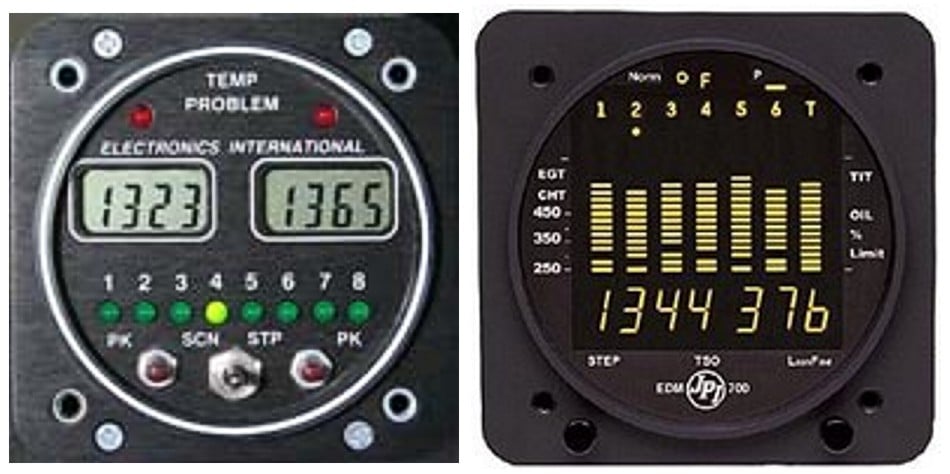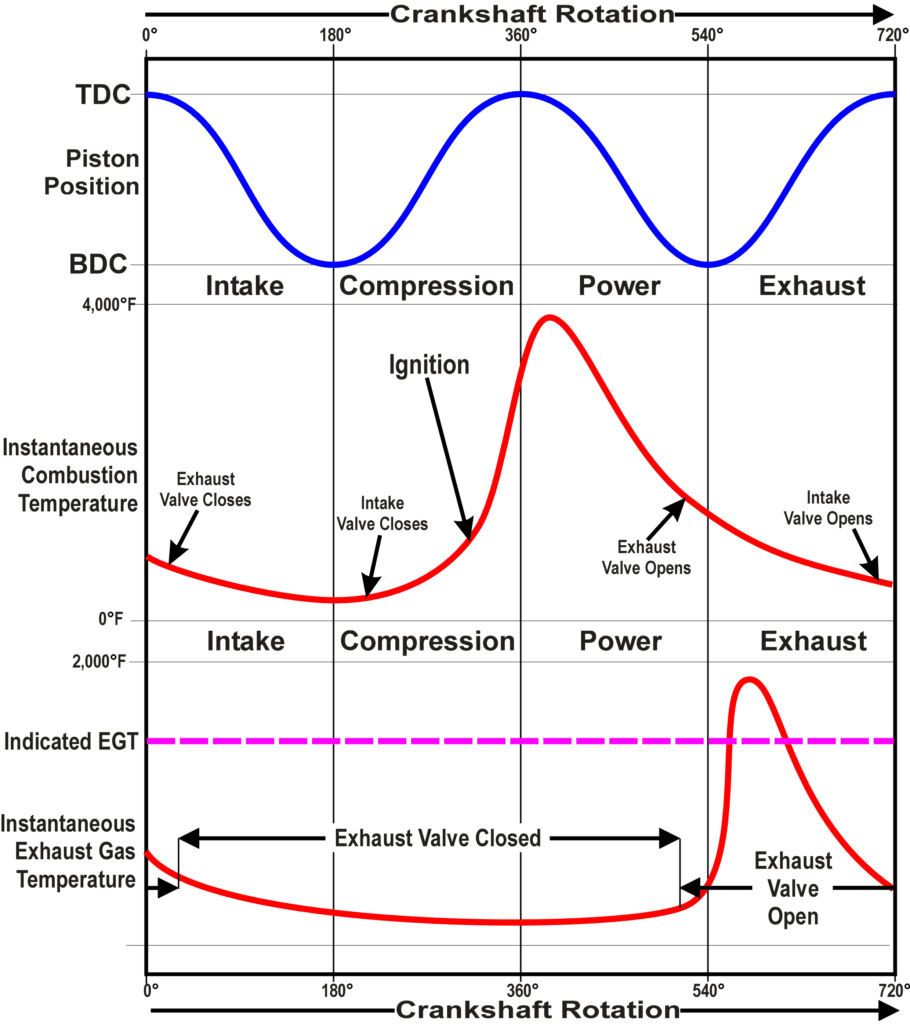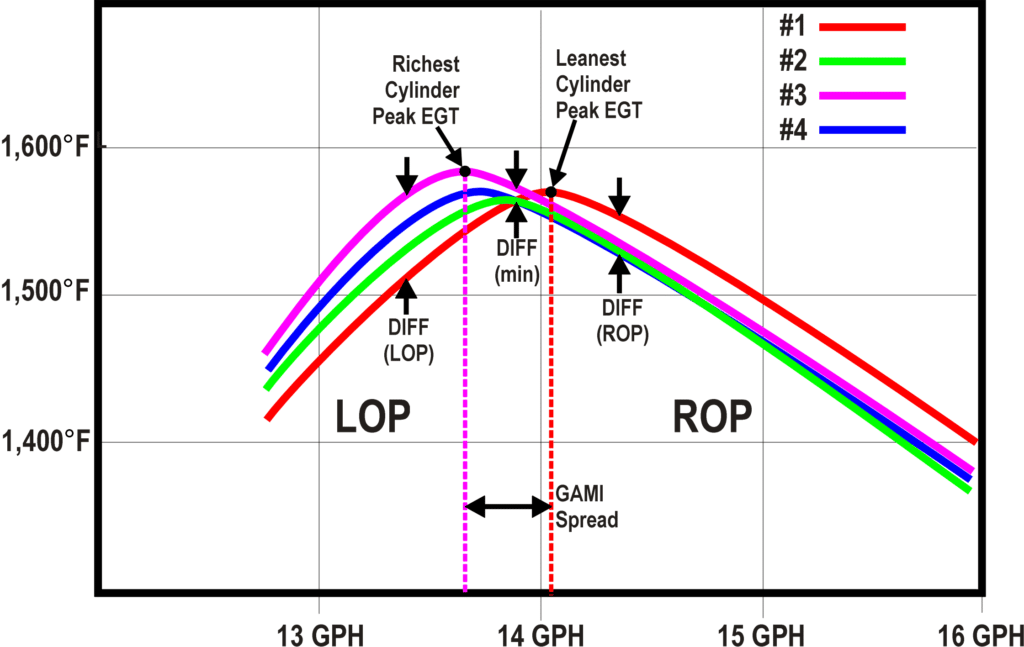Pilots still seem to have a lot of misconceptions about EGT. Let’s see if we can clear some of them up.
These days, pilots of piston-powered aircraft seem to be fixated upon exhaust gas temperature (EGT). Scarcely a day goes by that I don’t receive a phone call or email or support ticket asking some EGT-related question.
Pilots will send me a list of EGT readings for each of their cylinders and ask me if I think they look okay, whether I think their EGTs are too high, what maximum EGT limit I recommend, why their EGTs seem to be higher in the winter than in the summer, or why the EGTs on their 1972 Cessna 182 are so much higher than the ones on their friend’s 1977 model. They’ll voice concern that the individual cylinders on their engine have such diverse EGT readings, worry that the spread between the highest and lowest EGT is excessive, and ask for advice on how to bring them closer together. They’ll complain that they are unable to transition from rich-of-peak (ROP) to lean-of-peak (LOP) operation without producing EGTs that are unacceptably high.
Each of these questions reveals a fundamental misunderstanding of what EGT measures, what it means, and how it is interpreted. Let me attempt to clear up some of this confusion by asking you, dear reader, to forget everything you thought you knew about EGT and start at the beginning.
A Little History
When petroleum engineer Al Hundere introduced the very first EGT instrumentation for piston aircraft engines in the 1960s, he did something quite clever. The analog EGT gauges manufactured by his company Alcor (and widely installed by Beech, Cessna, Mooney, Piper, and other aircraft manufacturers) had no absolute temperature markings, but only a series of unlabeled tick-marks spaced 25°F apart, with an asterisk at 80% of full-scale. (See Figure 1.) As the pilot leaned the engine, the EGT needle rose to a peak value on the meter, then started to fall off. The pilot would note where the needle peaked, then would richen until the needle dropped by the desired number of tick marks (e.g., three for 75°F). The gauge provided the pilot no way to determine the absolute value of EGT (e.g., 1,475°F), but only its relative value (e.g., 75°F rich-of-peak).

Hundere understood that the absolute value of EGT is not particularly meaningful (we’ll see why shortly), and that presenting this information to the pilot would simply be a distraction. Since the Alcor EGT gauges provided no absolute temperature information, pilots never worried about whether their EGTs were too high or what the maximum EGT limit should be—and that was a good thing.
The first probe-per-cylinder engine analyzers introduced by Alcor and Bill Simkinson’s KS Avionics were arrays of vertical analog meter movements, and also provided only relative EGT information to the pilot. When John Youngquist introduced the original Insight graphic engine monitor (GEM), its novel LED bar-graph display also provided only relative EGT.

Things started getting confusing when Electronics International introduced its “Ultimate Scanner” that provided digital (rather than graphical) readouts of EGT, and touted its 1°F accuracy as being far superior to the 25°F granularity of the GEM’s bar-graph. (Never mind that the absolute EGT values it was reporting so accurately were essentially meaningless.) Not to be outdone, J.P. Instruments introduced its EDM-700 that featured both a GEM-like bar graph and an Ultimate Scanner-like digital readout on the same instrument. (See Figure 2.) The EDM-700 was a smashing market success, and forced both E.I. and Insight to respond with similar products (the UBG-16 and GEM 610, respectively).
Now pilots were being presented with precise digital values of absolute EGT, scary temperatures in the 1300s, 1400s, 1500s and even 1600s Fahrenheit. Few understood what these temperatures meant, but most assumed that—as with most other temperatures in aviation (CHT, TIT, OAT, oil temp, etc.)—cooler was better and hotter was worse.
What EGT Is Not
In fact, however, absolute values of EGT are not particularly interesting for a number of reasons. The most important is that indicated EGT is not a “real” temperature! To understand what I mean by this, I’d like you to conduct a thought experiment: Imagine that you’re an EGT probe, located in an exhaust riser between two and four inches from the exhaust port of a cylinder, and think about what you would see.

As Figure 3 illustrates, you’d see nothing much two-thirds of the time—during most of the intake, compression, and power strokes—because the exhaust valve is closed and so no exhaust gas is flowing out of the exhaust port and past the probe. During the one-third of the time that the exhaust valve is open, you’d see a constantly changing gas temperature that starts out very hot when the valve first opens but cools very rapidly as the hot compressed gas escapes and expands, and then ultimately is scavenged by cold induction air during the valve overlap period (at the end of the exhaust stroke and the beginning of the intake stroke) when both intake and exhaust valves are open simultaneously.
Now, all these gyrations are happening about 20 times a second, and you (the EGT probe) cannot possibly keep up them. So you wind up stabilizing at some temperature between the hottest and coolest gas temperature you see, and you dutifully report this rather arbitrary temperature to the panel-mounted instrument, where it is displayed to the pilot as a digital value accurate to one degree. The temperature you report to the pilot is not exhaust gas temperature (which is gyrating crazily 20 times a second), but rather exhaust probe temperature (which is stable but related to actual exhaust gas temperature in roughly the same fashion as mean sea level is to high tide).
To make matters worse, there are numerous factors that affect indicated EGT besides actual exhaust gas temperature. These include probe mass and construction (grounded or ungrounded), cam lobe profile, lifter leak-down rate, valve spring condition, and exhaust manifold topology, among others.
For example, the two front cylinders (#5 and #6) on the left engine of my Cessna T310R always indicate lower EGT than the other four cylinders. The exact same phenomenon also occurs on the right engine. This is not because those front cylinders produce cooler exhaust gas than their neighbors (they don’t), but because the exhaust risers for those cylinders curve aft while the other four risers go straight down. Thus, the gas flow past the EGT probe is different for the front cylinders than for the others, and their indicated EGT is lower. This temperature anomaly is quite obvious on my digital engine monitor—and also quite meaningless.
What EGT Means
Even if indicated EGT accurately reported actual exhaust gas temperature (which it doesn’t), it’s important to understand that exhaust gas temperature does not correlate with stress on the engine the way cylinder head temperature does. In fact, many things that increase engine stress (such as advanced ignition timing and high compression ratio) cause EGT to go down, while things that reduce engine stress (like retarded ignition timing and low compression ratio) cause EGT to go up.
Remember that CHT mainly reflects what’s going on in the cylinder during the power stroke when the cylinder us under maximum stress from high internal temperatures and pressures, while EGT mainly reflects what’s going on during the exhaust stroke after the exhaust valve opens and the cylinder is under relatively low stress.
High CHTs often indicate that the engine is under excessive stress, which is why it’s so important to limit CHTs to a tolerable value (no more than 400°F, preferably 380°F or less). By contrast, high EGTs do not indicate that the engine is under excessive stress, but simply that a lot of energy from the fuel is being wasted out the exhaust pipe rather than being extracted in the form of mechanical energy.
For instance, a 1972 Cessna 182 with an O-470-R engine will typically have indicated EGTs that are 100°F hotter than those seen in a 1977 Cessna 182 with an O-470-U engine. The -R has a relatively low 7.0-to-1 compression ratio because it was certificated for 80-octane avgas, while the -U engine has a much higher 8.6-to-1 compression ratio because it was certificated for 100-octane. Because the high-compression -U engine is significantly more efficient at extracting heat energy from the fuel, it wastes less energy out the exhaust and thus its EGTs are cooler (despite the fact that the -U engine is much more highly stressed than the –R).
High EGTs do not represent a threat to cylinder longevity the way high CHTs do. Therefore, limiting EGTs in an attempt to be “kind to the engine” is simply misguided.
DIFF vs. GAMI spread
Right behind the “high EGTs are bad” myth is the “identical EGTs are good” myth. Many pilots believe incorrectly that a flat-topped graphic engine monitor display (with all EGTs equal) is the mark of a well-balanced engine, and that unequal EGTs are a sign that something is wrong. This common misconception tends to be reinforced by digital engine monitors that display a digital “DIFF” showing the difference between the highest and lowest EGT indication.
As illustrated by the earlier anecdote about the front cylinders on my Cessna T310R, differences between absolute EGT values are both normal and benign. It is not uncommon for well-balanced fuel injected engines to exhibit EGT spreads of 100°F, and carbureted engines often have spreads of 150°F or more. In fact, as shown in Figure 4, EGT spreads are usually smallest near or just rich of peak EGT (the worst place to operate the engine), and often significantly greater at leaner or richer mixtures (that are much kinder to the engine).

The mark of a well-balanced engine is not a small EGT spread (“DIFF”), but rather a small “GAMI spread”—defined as the difference in fuel flows at which the various cylinders reach peak EGT. Ideally, we would like to see this spread be no more than about 0.5 GPH (or 3 PPH). Experience shows that if the GAMI spread is much more than that, the engine is unlikely to run smoothly with LOP mixtures.
It’s All Relative
Al Hundere had it right after all: The only important thing about EGT is its relative value: how far below peak EGT and in which direction (e.g., 100°F ROP or 50°F LOP). Absolute values of EGT (e.g., 1475°F) are simply not meaningful and are best ignored. There is no such thing as a maximum EGT limit or red-line, and trying to keep absolute EGTs below some particular value—or even worse, leaning to a particular absolute EGT value—is simply wrongheaded. Don’t do it. If you must fixate on those digital engine monitor readouts, fixate on something important like CHT.
SIDEBAR:
Turbine Inlet Temperature (TIT)
Turbocharged engines are often equipped with a turbine inlet temperature (TIT) gauge or a TIT probe connected to the aircraft’s digital engine monitor. Unlike EGT, absolute values of TIT are meaningful, because the TIT probe is mounted far downstream in the exhaust system where the gas flow past the probe is steady (not pulsed) and has relatively steady temperature (not constantly fluctuating). Observance of an absolute TIT red-line (typically 1650°F or 1750°F) is appropriate and prudent in order to obtain maximum useful life from the turbocharger. —MB
You bought a plane to fly it, not stress over maintenance.
At Savvy Aviation, we believe you shouldn’t have to navigate the complexities of aircraft maintenance alone. And you definitely shouldn’t be surprised when your shop’s invoice arrives.
Savvy Aviation isn’t a maintenance shop – we empower you with the knowledge and expert consultation you need to be in control of your own maintenance events – so your shop takes directives (not gives them). Whatever your maintenance needs, Savvy has a perfect plan for you: